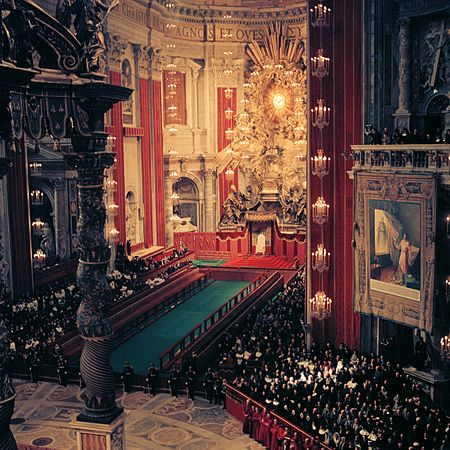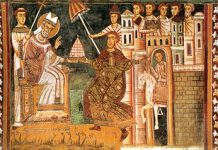Newton’s Third Law has many applications, as does Hegel’s dialectic of thesis-antithesis-synthesis, in that eternal struggle of the World Spirit – even in the ecclesial and theological realm. For the Church, in her earthly manifestation, reels from crisis to crisis, seeming to totter, even approach collapse, but rising stronger, like a phoenix from the ashes, until the final revelation of her eternal perfection and glory.
It is in this light that we should see the unfolding controversy surrounding Archbishop Carlo Maria Vigano, who has become more intransigent seemingly with each passing day. Papal nuncio to the United States from 2011-2016, he has striven to present the truth, not least of former-cardinal McCarrick’s misdemeanours, along with whoever else aided and abetted.
The Archbishop seems to see himself as the ‘thesis’ to the ‘antithesis’ of the complacent, comfortable and compliant Church, striving as he approaches his octogenarian years to make up for lost time – a Newtonian counter-reaction to what he perceives perhaps as his own earlier concessions omissions, to take back the land he allowed to be conquered by the forces.
Which would be fine, but he seems to have gone a bridge too far of late and is in proximate danger of entering the abyss of schism, and dragging a whole lot of people with him.
The ubiquitous Taylor Marshall, about whom I know little, is not helping matters. The title of his recent podcast, ‘Is Archbishop Vigano in Schism? No!’, is not (yet) the right question to ask.
Marshall’s sub-title is more accurate, that is, whether His Grace is on the brink of schism, to which the answer, to my mind, is yes. So far, he has been careful enough not to topple over the edge, and has framed his exhortations in the form of, well, exhortations. He has not – explicitly and formally – rejected Vatican II, but has called for us – and, we may ask, who is ‘us’ – to do so.
The Code of Canon Law, which I presume the Archbishop still accepts as binding, even though it is a post-conciliar document:
schism is the refusal of submission to the Supreme Pontiff or of communion with the members of the Church subject to him (CIC, 751)
A significant part of that ‘submission’ and ‘communion’ is accepting the formal decisions of Magisterium – the Pope and the bishop in union with him – whether we like them or not.
And the Pope and the bishops – almost to a man – ratified the documents of the Second Vatican Council by overwhelming majorities.
Yes, one could argue there are deficiencies and even omissions in the documents, but no heresies, and nothing contrary to Church teaching.
And we should all be aware that it is not just ‘Vatican II’ that would be rejected, but all that has happened since Vatican II, all the other documents, decrees, encyclicals, decisions, the whole modus docendi et vivendi of the Church, the entire papacies of John Paul II and Benedict XVI.
We should be clear that there is no ‘reset’ button in the Church, which must absorb what has happened, what has been decided, always striving to be more perfect. Things move on, doctrine and praxis develops, and, as mentioned in my previous article, corrections are ‘built in’ to the system, without the need to undermine or even blow up that very system.
I can’t help but wonder, however, to what pristine time would the Archbishop have us reset to? Were the liturgical and other reforms of Pius XII too much? The loss of the claim to the papal states under Pius XI? What of the daily Communion advocated by Pius X? Or of Leo XIII’s advocacy of democratic regimes?
One’s mind reels at the cascading and catastrophic if the principle underlying Archbishop Vigano’s stance were to be accepted.
Extrema se tangunt, the Latin proverb says: ‘Extremes touch each other.’ We would end up adopting the very modernist and protestant mindset that we all want to avoid: We will decide what is orthodoxy and orthopraxy, what to accept and not accept – and what crudescent excess or deviations must be removed.
I will only say a couple of things for now concerning the Archbishop’s recent interview with Phil Lawler, and that it he seems to misunderstand the role of the sensus fidelium (or the sensus fidei, as he puts it). This is a complex topic, but there is no precedent, and no theological principle, by which the faithful can rejected a promulgated and ratified Ecumenical Council in toto. That is simply not how the Church operates. The ‘faithful’ may help the Magisterium discern a doctrine or devotion before it is defined, or to sharpen and clarify doctrines once defined (in a general way).
This was Archbishop Vigano’s position until recently, when he developed a more intransigent stance.
The ‘sense of the faithful’ simply cannot reverse officially proclaimed ecumenical Councils. There is no, and never will be, precedent for such.
The Archbishop further polarizes this situation, with an ‘either you’re with me, or against me’ tone. I, for one, along with many others, are not defending the conciliar documents, such as Nostra Aetate, as he claims ‘with knives drawn’. We all realize the Vatican documents – or any issuance of the Magisterium – have the authority nor the infallibility of Scripture, or that the bishops at the Council were divinely inspired in the same way. But Council are kept from teaching erroneous doctrine, and was an event moved by the Holy Spirit, and is part of the perennial Magisterium of the Church. The Archbishop’s claim that all the errors of the modern era are contained in nuce (in a nutshell) in the conciliar documents is a rather poisonous red herring.
Are we to conclude that those who in any way support the Council – and the Church since, – are now in the category of schismatics, members of that parallel ‘apostate’ Church that Vigano describes? Alas, and alas again. Think twice, and a third time, before you make that leap. If schism is to come, let us not be the ones to precipitate it.
Reflect upon the sober words of Pope Benedict XVI from his 2005 Christmas address, and his call for a hermeneutic of continuity, as opposed to one of rupture (a distinction that Archbishop rejects, claiming the whole thing was just rupture). Benedict’s words – that the Council, in line with Pope John XXIII’s purpose, to present the ancient truths of the Church in a new mode and key – deserve to be read in their entirety, and in context, as do the conciliar documents.
The tragic thing is that many of use may well have been with the Archbishop in his call for such ongoing reform, for correction, for clarification, of the conciliar documents and many other aspects of our beleaguered Church. He has more than a point. The Church is in a perilous state. But we cannot be with him in his call for a rejection of the Council, which would undo the very principles that holds the Church as a Church. (The reflections by di Sandro Magister are also helpful).
Christ is protecting His Church, which He promised He would be with unto the end of time. We must trust, hope, and bide our time, allow Christ and His Holy Spirit to act, all the while doing what we called to, within the historical continuity of that same Church, outside of which, really, all is lost.











